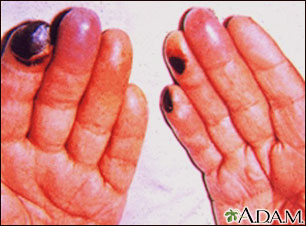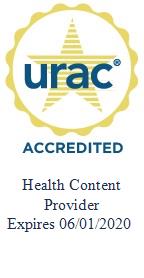Health Library
Fingers that change color
Blanching of the fingers; Fingers - pale; Toes that change color; Toes - pale
Fingers or toes may change color when they are exposed to cold temperatures or stress, or when there is a problem with their blood supply.
Images


I Would Like to Learn About:
Causes
These conditions can cause fingers or toes to change color:
- Buerger disease
- Chilblains (painful inflammation of small blood vessels)
- Cryoglobulinemia
- Frostbite
- Necrotizing vasculitis
- Peripheral artery disease
- Raynaud phenomenon (sudden change in the finger color ranges from pale to red to blue)
- Scleroderma
- Systemic lupus erythematosus
Home Care
Things you can do to help prevent this problem include:
- Avoid smoking.
- Avoid exposure to cold in any form.
- Wear mittens or gloves outdoors and when handling ice or frozen food.
- Avoid getting chilled, which may happen following any active recreational sport or other physical activity.
- Wear comfortable, roomy shoes and wool socks.
- When outside, always wear shoes.
When to Contact a Medical Professional
Call your health care provider if:
- Your fingers change color and the cause is not known.
- Your fingers or toes turn black or the skin breaks.
What to Expect at Your Office Visit
Your provider will perform a physical exam, which will include close examination of your hands, arms, and fingers.
Your provider will ask questions about your medical history and symptoms, including:
- Did the fingers or toes suddenly change color?
- Has the color change occurred before?
- Does the cold or changes in your emotions cause your fingers or toes to turn white or blue?
- Did the skin color changes occur after you had anesthesia?
- Do you smoke?
- Do you have other symptoms such as finger pain? Arm or leg pain? A change in the texture of your skin? Loss of hair on your arms or hands?
Tests that may be done include:
- Antinuclear antibody blood test
- Blood differential
- Complete blood count (CBC)
- Comprehensive metabolic panel
- Duplex Doppler ultrasound of the arteries to the extremities
- Serum cryoglobulins
- Serum protein electrophoresis
- Urinalysis
- X-ray of your hands and feet
Treatment depends on the underlying cause.
Related Information
Blue discoloration of the skinRaynaud phenomenon
References
Jaff MR, Bartholomew JR. Other peripheral arterial diseases. In: Goldman L, Schafer AI, eds. Goldman-Cecil Medicine. 26th ed. Philadelphia, PA: Elsevier; 2020:chap 72.
Robert A, Melville I, Baines CP, Belch JJF. Raynaud phenomenon. In: Hochberg MC, Gravallese EM, Silman AJ, Smolen JS, Weinblatt ME, Weisman MH, eds. Rheumatology. 7th ed. Philadelphia, PA: Elsevier; 2019:chap 154.
BACK TO TOPReview Date: 5/3/2021
Reviewed By: Linda J. Vorvick, MD, Clinical Associate Professor, Department of Family Medicine, UW Medicine, School of Medicine, University of Washington, Seattle, WA. Also reviewed by David Zieve, MD, MHA, Medical Director, Brenda Conaway, Editorial Director, and the A.D.A.M. Editorial team.
 | A.D.A.M., Inc. is accredited by URAC, for Health Content Provider (www.urac.org). URAC's accreditation program is an independent audit to verify that A.D.A.M. follows rigorous standards of quality and accountability. A.D.A.M. is among the first to achieve this important distinction for online health information and services. Learn more about A.D.A.M.'s editorial policy, editorial process and privacy policy. A.D.A.M. is also a founding member of Hi-Ethics. This site complies with the HONcode standard for trustworthy health information: verify here. |
The information provided herein should not be used during any medical emergency or for the diagnosis or treatment of any medical condition. A licensed medical professional should be consulted for diagnosis and treatment of any and all medical conditions. Links to other sites are provided for information only -- they do not constitute endorsements of those other sites. © 1997- 2022 A.D.A.M., a business unit of Ebix, Inc. Any duplication or distribution of the information contained herein is strictly prohibited.
